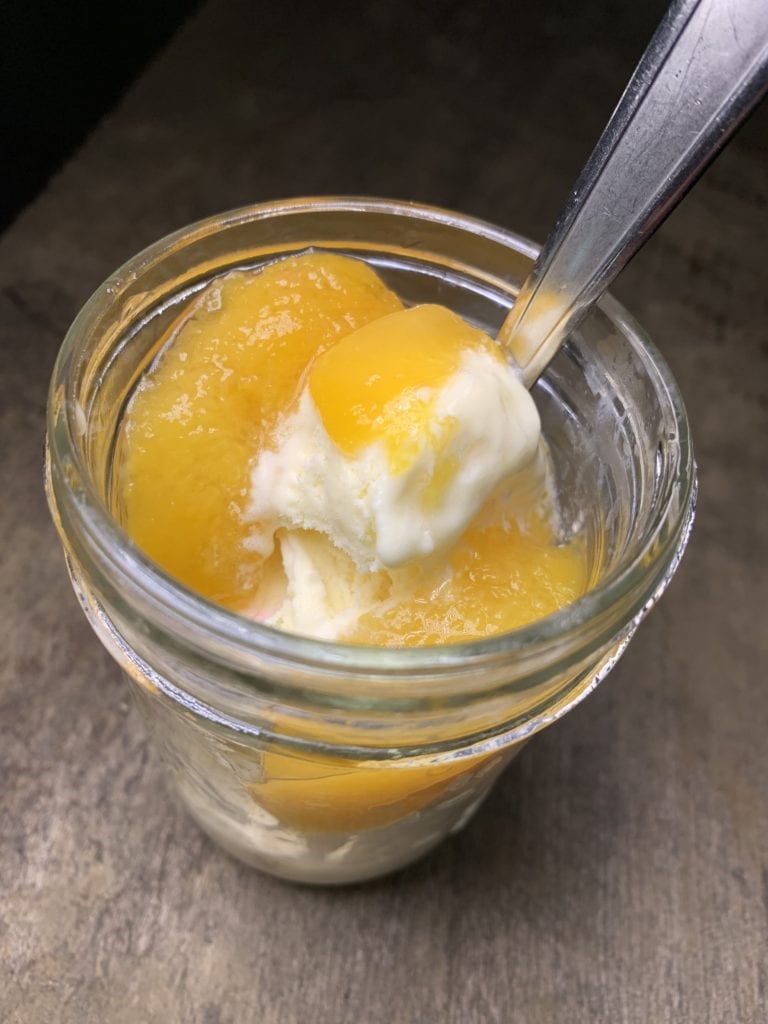Ms. Olivia’s Sweet Peaches
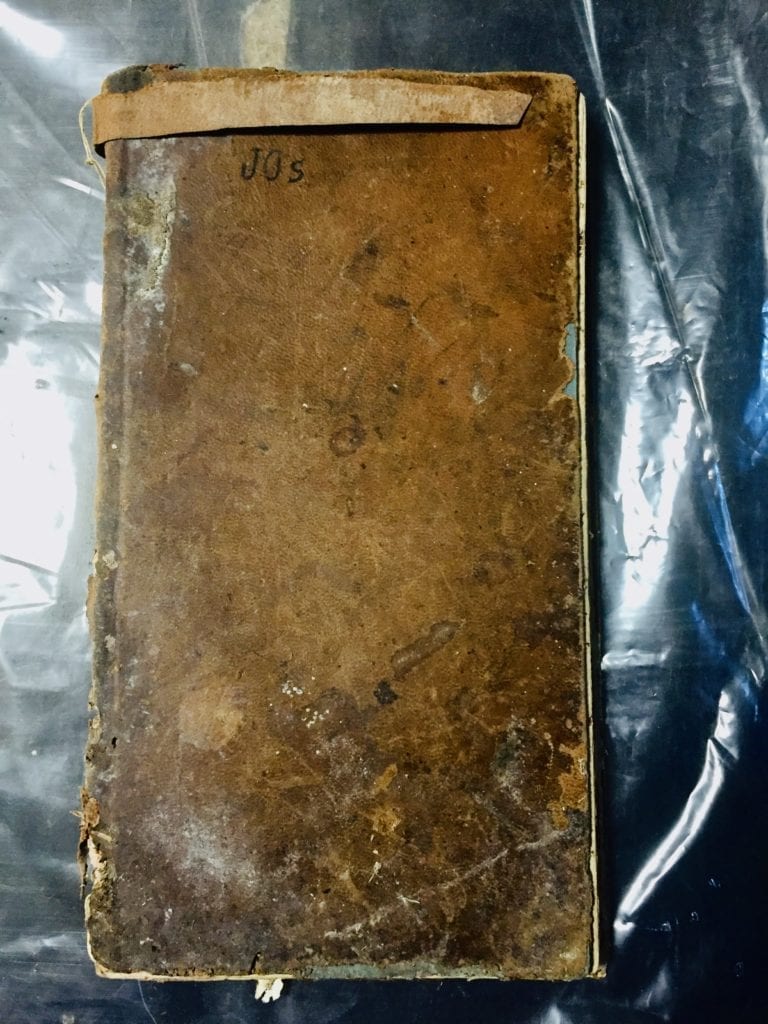
A peach buzz began to swirl.
There was a buzz among the locals that a peach truck was scheduled to deliver in our small town. There is nothing like access to good foods that aren’t typical of your area. A friend called to let me know it was coming and we started thinking about all of the ways to use bags of peaches. Little did I know, there was a local about 160 years ago, whose intriguing peach recipe would fall into my hands.
The younger kids had been outside playing tag. Our daughter, Josie, was visiting with our neighbor, Lisa, catching her up on all of the garden and canning adventures we were having. Lisa said, “Your mom likes old things. She might like to look at an old journal I found.”
Like handling a piece of delicate china.
Josie came in the house with a big smile and a small, brown, weathered and worn-looking journal in a bag. “Mom, Lisa said you can borrow this! It’s from the 1800’s!” Oh my! I felt like I was just handed delicate china to balance on my head. I cleaned off our kitchen table and made sure my hands were clean….”Really?” I was so curious about what was in these pages- but I was so fearful of anything damaging it in our care. “Yes, Mom. Lisa took it out of the bag and showed me. It’s okay.”
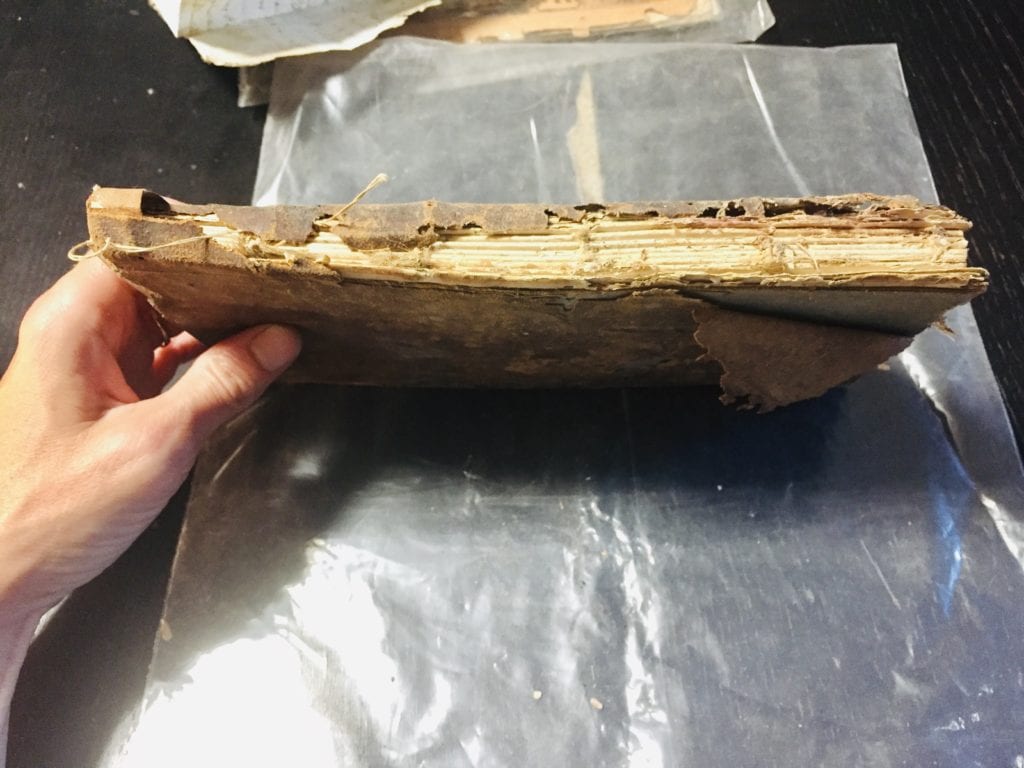
The cover was brown and spotted with age. The spine was barely there, hardly holding the journal together. I breathed slow and deep. The smell of this old book infiltrated my nostrils. I started to follow every curve that the ink dipped pen left behind. On the inside cover it read to whom this journal belonged: “Ms. Olivia A. Priest’s Book (Book was underlined twice.). “A present from her Father, Mr. F. L. Priest, Sep. 15th, 1854.” It was signed at the bottom, “Olivia Ann Priest.” There were pretty doodles of curves, dots, growing plant life, and dollar bill symbols. She must have been proud of it.
A treasure of a barn find.
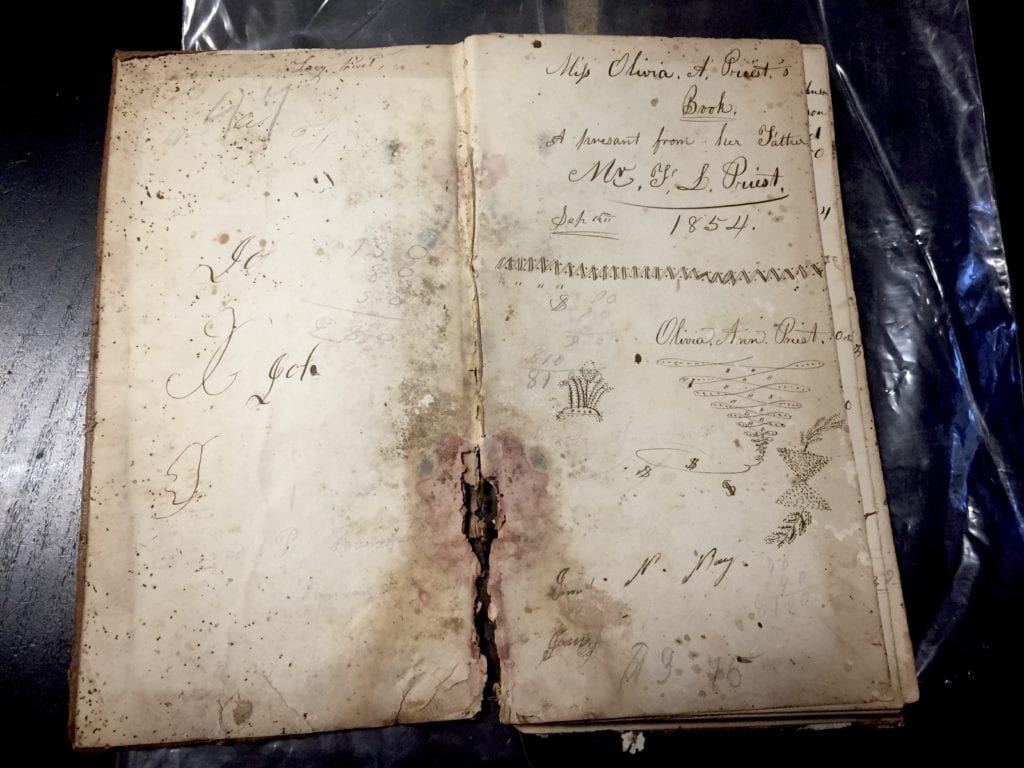
The journal was found in an old barn that was about to be demolished by construction workers so that a retail store could be built. After driving by the barn, our neighbor noticed the contents of the barn were still there on the day of demolition. Lisa asked if she could take a quick look after inquiring what would become of the items. The workers told her the items were going to be destroyed. She was given permission to keep what she found. There was the journal. It was unprotected from time and waiting to become dust with the ground.
Ms. Olivia was a woman ahead of her time.
Much of the journal is a ledger of accounts. Ms. Olivia kept documentation for her father, of money charged for selling corn, bushels of oats, “help to thrash oats,” and “help delivering a black mare to town to sell.” On November 23, 1854, she got an order from Ben Estes to make a “pee jacket and pantaloons.” There were payments on an account for a deceased Samuel Johnson, that his son Gabriel Johnson made payments on. Another account places the journal directly to this area, with an order and delivery charge for chickens, meat, sweet potato slips, oats, eggs, and butter. This detailed it would take 4 loads from Louisville, at $4 per load. There were also “hides” given in exchange for cash, in the amounts of $4.83 and $5.04.
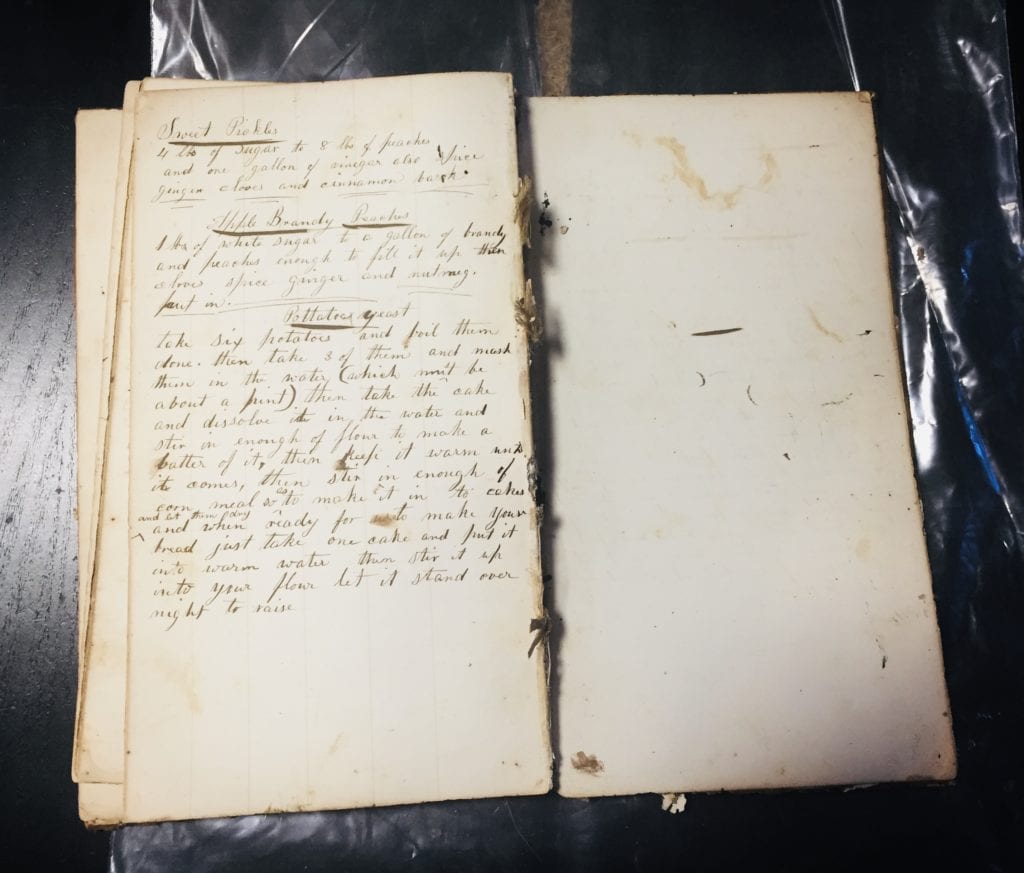
Ms. Olivia not only kept the family business organized, she had a fun section in the back of her journal of interests. She had candle making notes that used lard as an ingredient, how to make “vegetable cosmetic lotion,” and also some recipe notes on “potato yeast,” “apple brandy peaches,” and “sweet peaches.” These notes were far from the kind of scientific recipes we see in modern times with exact quantities and measurements. In the 1850’s, Ms. Olivia already knew how to preserve food- she only jotted down the ingredients. There were warm spices of cloves, ginger, and cinnamon bark written under “Sweet Peaches.” Since these items are grown in tropical regions, it was probably exciting to have access to these spices- especially around the the time of the Civil War.
Ms. Olivia’s sweetest legacy.
I was particularly interested in Olivia’s notes about the “Sweet Peaches,” especially since peaches were ripe and fresh around the time of reading her journal. As a beginning homesteader, trying to learn as much as possible, I’ve worked hard on water bath canning the last two summers. I took what I have learned and applied it to Ms. Olivia’s Sweet Peaches recipe. The ingredients were similar to a “Pickled Peaches” recipe I have… and offer more of an idea to the taste. Let me just say, “Zing! Wow! Intriguing!” We took our summer peach-filled mason jars from the shelf and popped off the lid. We highly recommend spooning some of these pickled peaches directly onto vanilla ice cream… and we almost guarantee you that it will be something you had not expected. It is surprising. There are layers of opposite flavors that give wonderful interest and delight. I had originally labeled my jars, “1850’s Pickled Peaches,” but I’ve got to give Ms. Olivia credit for jotting down her wonderful notes and bringing some zip to our modern day.
How to make Ms. Olivia’s Sweet Peaches a.k.a. 1850’s Pickled Peaches:
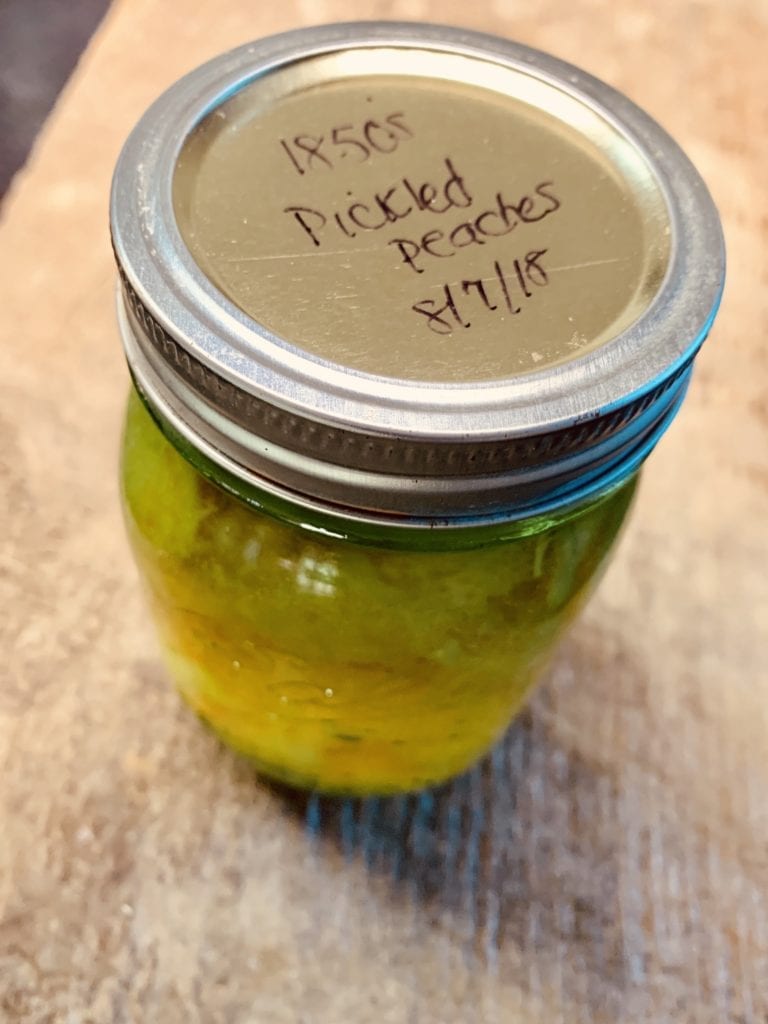
4 c. granulated sugar
4 lbs. peeled and sliced peaches
(Blanch rinsed whole peaches 1 min. in boiling water, then dunk in cold. Peel.)
8 c. white vinegar
3 cinnamon sticks broken in half
1 TB. fresh ground ginger
1 tsp. whole cloves
- Allow the vinegar and sugar to boil. Drop in the peaches and cook until tender.
- Add spices.
- Fill jars leaving ½-inch headspace.
- Process in a boiling water bath, 8 minutes.
- Turn off heat and remove canner lid to cool 5 minutes.
- Remove jars and cool 12 hours on counter.
- Lids should “ping” when sealed.
*I did not use a fruit protector in my recipe. When we pulled down our jars after sitting for 7 months, the peaches on top were brown. I wanted to try the recipe using the ingredients in the journal, without adding anything. I wanted to have the same experience that Ms. Olivia may have had. Still tasty… I think next time I will add Ball Fruit-Fresh Produce Protector so our peaches can retain their color.
